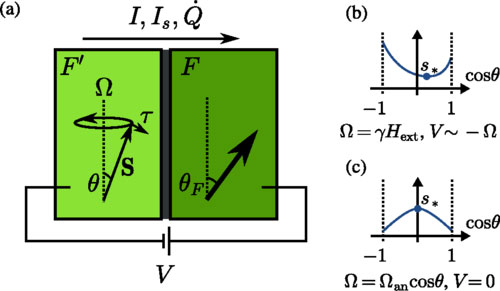| Posted: Jun 12, 2017 |
Quantum theory for manipulating nanomagnets
(Nanowerk News) Researchers at the Department of Physics, University of Jyväskylä, Finland, have created a theory that predicts the properties of nanomagnets manipulated with electric currents. This theory is useful for future quantum technologies. The research was published in Physical Review Letters ("Spin Pumping and Torque Statistics in the Quantum Noise Limit").
|
 |
| a) Tunnel junction between magnetic materials with free (F') and fixed (F) magnetizations, biased by voltage V. The total spin S=VM/Γ in F' precesses at angular frequency Ω around the Ζ axis. The motion pumps charge, spin, and heat currents through the junction, and the backaction spin transfer torque τdrives a change in the tilt angle θ. (b)–(c) Schematic of the effective magnetic potential energy, in the presence of an external field Hext and large spin transfer torque, or, in the presence of a magnetic anisotropy Ωan=γHan. © PRL)
|
How to make faster magnetic memories?
|
|
In computer hard drives the information is stored in the magnetic states of small nanomagnets as zeros and ones. “Zero” is thus coded as the south-north magnetization, and “one” as the “north-south” magnetization. Writing information thus requires turning the magnetization, whereas reading it means finding out the magnetization state.
|
|
The speed of hard drives thus depends on how fast these processes can be realized. The reading process is based on electric currents and therefore can be made fast. On the other hand, writing usually has to be made via magnetic fields, which is much slower. For over 20 years physicists have known a process, spin transfer torque, with which also writing could be realized with the help of electric current.
|
|
The problem hindering its use in commercial products is the heating this process causes. Because of this heating, the process is more prone to errors. Switching the magnetization state is a stochastic process, which means that the final outcome is not certain. The problem becomes harder as the temperature increases.
|
Random precession of magnetization
|
|
The researchers managed to develop a theory with which to evaluate the probability of the changes in the magnetization in situations where it is manipulated by electric current. The same theory provides the probability of the reciprocal process, spin pumping, where the motion of the magnetization pumps current into the circuit.
|
|
This latter process is used for radio frequency generation, and also it is stochastic, which means that the pumped current has random fluctuations, noise. In particular, the researchers managed to find out how this noise behaves in the quantum limit of magnetization precession, where the precession frequency is large. Earlier work had concentrated on low frequencies. Therefore, this work will be particularly useful for magnetism-based quantum technologies.
|
|
The result is very general and simple, but finding it required the use of complicated theory tools.
|
|
“Finding the result required a lot of thinking and derivations, but I am very happy with the outcome”, tells post-doctoral researcher Pauli Virtanen, now in Scuola Normale Superiore, Pisa, who took care of the detailed calculation. Professor Tero Heikkilä, who provided the idea of the work, continues: “This type of calculation requires a lot of deep intuition. Now our result can be generalized to more complex magnetic structures.”
|

